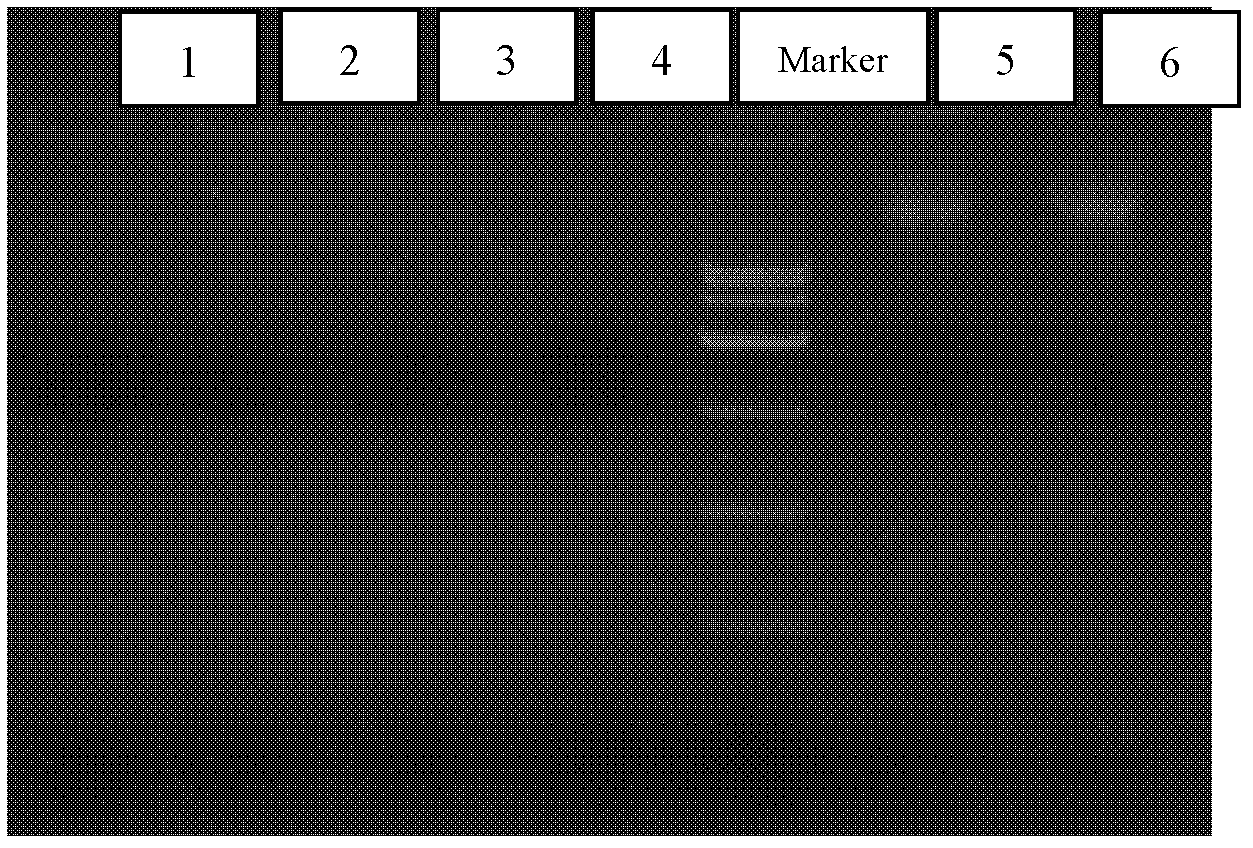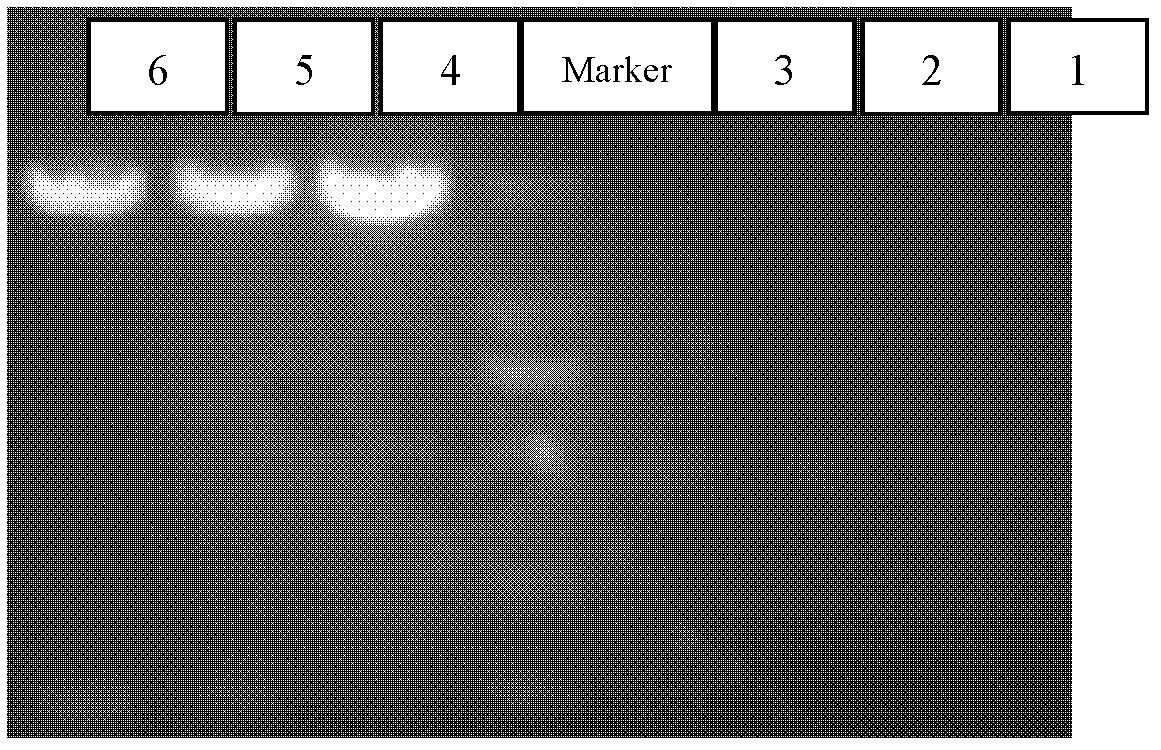Method for purifying propionibacterium strain plasmid
A technology of Propionibacterium and strains, which is applied in the field of plasmid purification of Propionibacterium strains, can solve the problems of plasmid screening, extraction and purification methods that are not mentioned, and achieve the effect of improving purity and extraction efficiency
- Summary
- Abstract
- Description
- Claims
- Application Information
AI Technical Summary
Problems solved by technology
Method used
Image
Examples
Embodiment 1
[0016] (1) Inoculate 6 bottles of medium, 200mL per bottle, and culture at 30°C for 35h, centrifuge at 4°C, 10,000g for 3min, remove the supernatant, and obtain six tubes of bacterial sediment, numbered 1-6 respectively.
[0017] (2) Wash the six tubes of cells with 10 mL SET eluent, centrifuge at 4°C and 10,000 g for 3 min, remove the supernatant, and dry the pellet to obtain the wet weight.
[0018] (3) Add 10 mL of solution I to suspend thoroughly.
[0019] (4) Add 1mL lysozyme solution respectively, 37°C water bath, No. 1 water bath for 0 min, No. 2 water bath for 30 min, No. 3 water bath for 0 min, No. 4 water bath for 30 min, No. 5 water bath for 30 min, and No. 6 water bath for 60 min.
[0020] (5) Add 400mL proteinase K solution, 56°C water bath, No. 1 water bath for 0 min, No. 2 water bath for 0 min, No. 3 water bath for 30 min, No. 4 water bath for 30 min, No. 5 water bath for 60 min, and No. 6 water bath for 30 min;
[0021] (6) Add 20mL of newly prepared solution ...
Embodiment 2
[0030] (1) Inoculate 6 bottles of culture medium, incubate 300mL of each bottle at 30°C for 35 hours, centrifuge at 4°C and 10,000g for 3min, remove the supernatant, and obtain six tubes of bacterial sediment, numbered 1-6.
[0031] (2) Wash the six tubes of cells with 10 mL SET eluent, centrifuge at 4°C and 10,000 g for 3 min, remove the supernatant, and dry the pellet to obtain the wet weight.
[0032] (3) Add 30mL solution I to suspend thoroughly.
[0033] (4) Add 1mL mutanolysin solution respectively, 37°C water bath, No. 1 water bath for 0 min, No. 2 water bath for 30 min, No. 3 water bath for 0 min, No. 4 water bath for 30 min, No. 5 water bath for 30 min, and No. 6 water bath for 60 min.
[0034] (5) Add 300mL proteinase K solution, 56°C water bath, No. 1 water bath for 0 min, No. 2 water bath for 0 min, No. 3 water bath for 30 min, No. 4 water bath for 30 min, No. 5 water bath for 60 min, and No. 6 water bath for 30 min;
[0035] (6) Add 15mL of newly prepared solutio...
Embodiment 3
[0044] (1) Inoculate 6 bottles of culture medium, incubate 300mL of each bottle at 30°C for 35 hours, centrifuge at 4°C and 10,000g for 3min, remove the supernatant, and obtain six tubes of bacterial sediment, numbered 1-6.
[0045](2) Wash the six tubes of bacterial cells with 30 mL SET eluent, centrifuge at 4°C and 10,000 g for 3 min, remove the supernatant, and dry the precipitate to obtain the wet weight.
[0046] (3) Add 10 mL of solution I to suspend thoroughly.
[0047] (4) Add 1mL lysozyme solution and 1mL mutanolysin solution, respectively, in 37°C water bath, No. 1 water bath for 0 min, No. 2 water bath for 30 min, No. 3 water bath for 0 min, No. 4 water bath for 30 min, No. 5 water bath for 30 min, and No. 6 water bath for 60 min.
[0048] (5) Add 900mL proteinase K solution, 56°C water bath, No. 1 water bath for 0 min, No. 2 water bath for 0 min, No. 3 water bath for 30 min, No. 4 water bath for 30 min, No. 5 water bath for 60 min, and No. 6 water bath for 30 min; ...
PUM
 Login to View More
Login to View More Abstract
Description
Claims
Application Information
 Login to View More
Login to View More - Generate Ideas
- Intellectual Property
- Life Sciences
- Materials
- Tech Scout
- Unparalleled Data Quality
- Higher Quality Content
- 60% Fewer Hallucinations
Browse by: Latest US Patents, China's latest patents, Technical Efficacy Thesaurus, Application Domain, Technology Topic, Popular Technical Reports.
© 2025 PatSnap. All rights reserved.Legal|Privacy policy|Modern Slavery Act Transparency Statement|Sitemap|About US| Contact US: help@patsnap.com



